Rewinding the Season with Norwich City
The Canaries entered the 2019/20 Premier League season with an abundance of hope, fresh from finishing their promotion campaign in the Championship on top of the pile with a notable 94 points, 5 clear of runners-up Sheffield United and a whole 11 from Leeds United back in third-place, Daniel Farke would have surely been confident of steering the new boys to safety in their return season to the top flight. However, this has not played out in the manner to be expected.
Despite some plaudits for their perceived approach and style of play, their season has waned off leaving them cut adrift from relegation rivals with only a handful of matches remaining. This poses the question, why have Norwich been cut adrift so clearly from the relegation scrap above and if the season could hypothetically be rewound, what changes could be implemented from an analytical and coaching perspective to boost survival chances and perhaps keep Norwich in the Premier League?
Analysing Performance & Improvement Areas
It is fundamentally important, that to develop an understanding of Norwich’s position there is a comprehensive evaluation of their performance across the season, thus highlighting areas which could be improved or adapted within a hypothetical season rewind. Therefore, in order to produce an in-depth analysis the following sections will be broken down using a combination of methodological approaches as follows. The first section will revolve around objective statistical analysis and provide a data-based underpinning into the successful and unsuccessful aspects of Norwich’s performance to reveal the deficiencies that could be improved upon. Using this as a foundation, the second section will analyse from a tactical perspective the areas highlighted within the statistical analysis to provide tactical improvements, through the use of coaching implementations to increase effectiveness of performance. It must be highlighted that this piece is focusing upon analytical and coaching interventions specifically, there will be no link to other factors that may have influenced success such as recruitment policies.
Section 1 – Analysing Norwich’s Performance
The first aspect to uncover is Norwich’s approach from a systematic perspective, with analysis of the formations and extent of tactical flexibility they have displayed during the season. From the graphic below, we can see clearly that Norwich have been rigid throughout the season using a 4-2-3-1 in 71% of their matches in the Premier League.
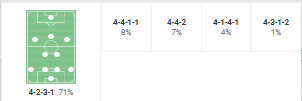
This is compounded further when considering that in reality the 4-4-1-1- and 4-4-2, which have been used an additional 15% of the time when combined, are merely tactical adaptations to the aforementioned 4-2-3-1. This is by either having the 7 and 11 pinned back by continuously advancing opposition full-backs (as was demonstrated against Liverpool) or pushing the 10 closer to the 9 in the 4-4-1-1 and 4-4-2 respectively. It is unsurprising that all Norwich’s wins have come using the 4-2-3-1, given its high level of familiarity. Although, it does raise the query of whether Norwich’s tactical rigidity has cost them further opportunities to pick up vital points, an area to be examined within this piece.
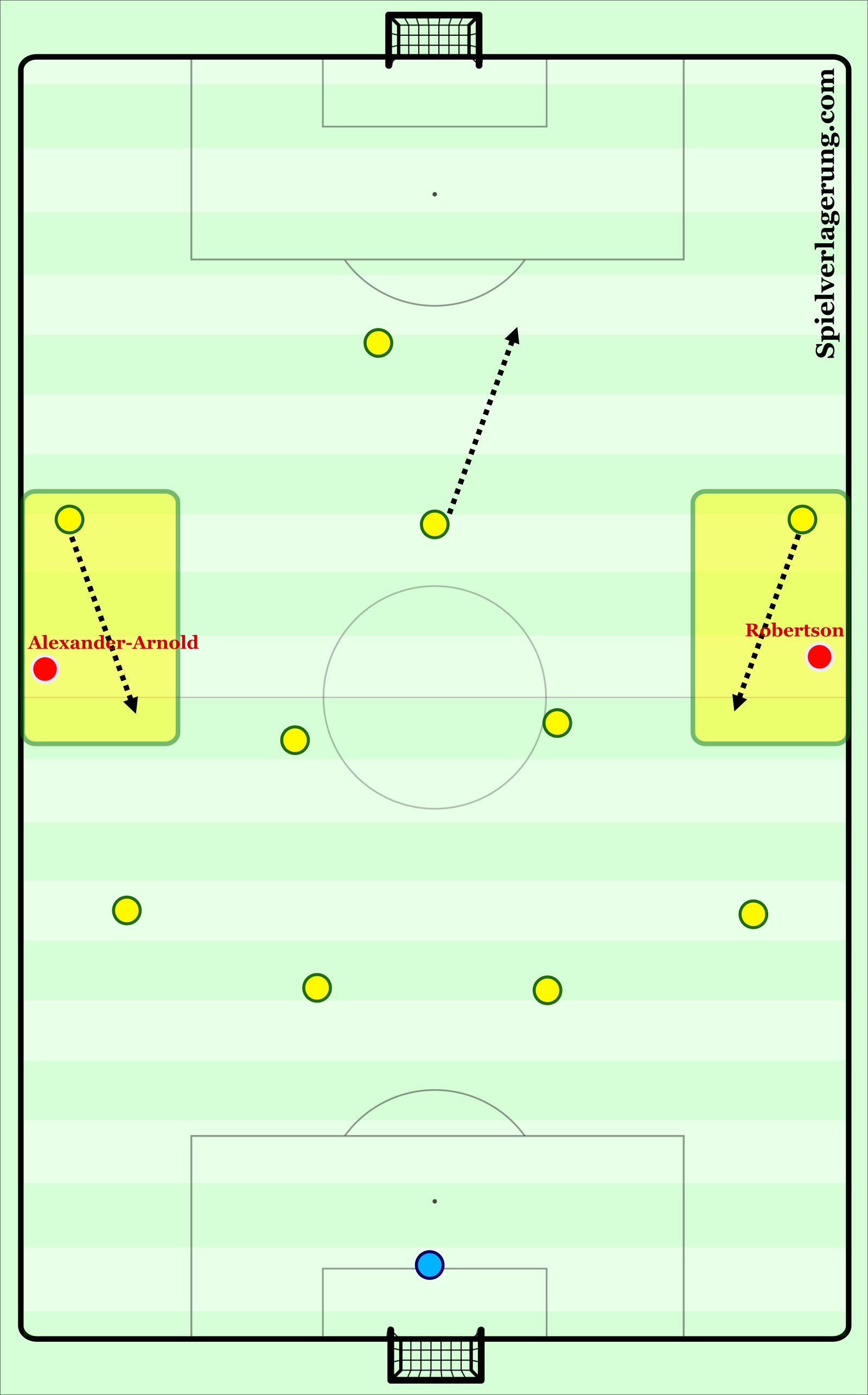
Shifting a focus upon statistical evidence of Norwich’s performance within matches, the first glaring area to observe is their defensive performance. There a number of damning statistics within this area:
- 60 Goals Conceded/1.74 Goals Against per Game (Most in the Premier League)
- 58.98 xG Against (2nd Most in the Premier League)
- 472 Shots Against/13.71 Shots Against per 90 Minutes (2nd Most in the Premier League)
Therefore, without doing a plethora of statistical examination the facts are evidently clear that Norwich are conceding far too many goals for a team that has ambitions of retaining their Premier League status. Furthermore, the relationship between Goals and xG with its close proximity also indicates that this isn’t down to chance with perhaps some unfortunate goals conceded, the simple explanation is that Norwich are allowing far too many clear opportunities to their opposition on a regular basis. In order to examine this further, the locations of all conceded goals and assists of goals conceded can be found below.
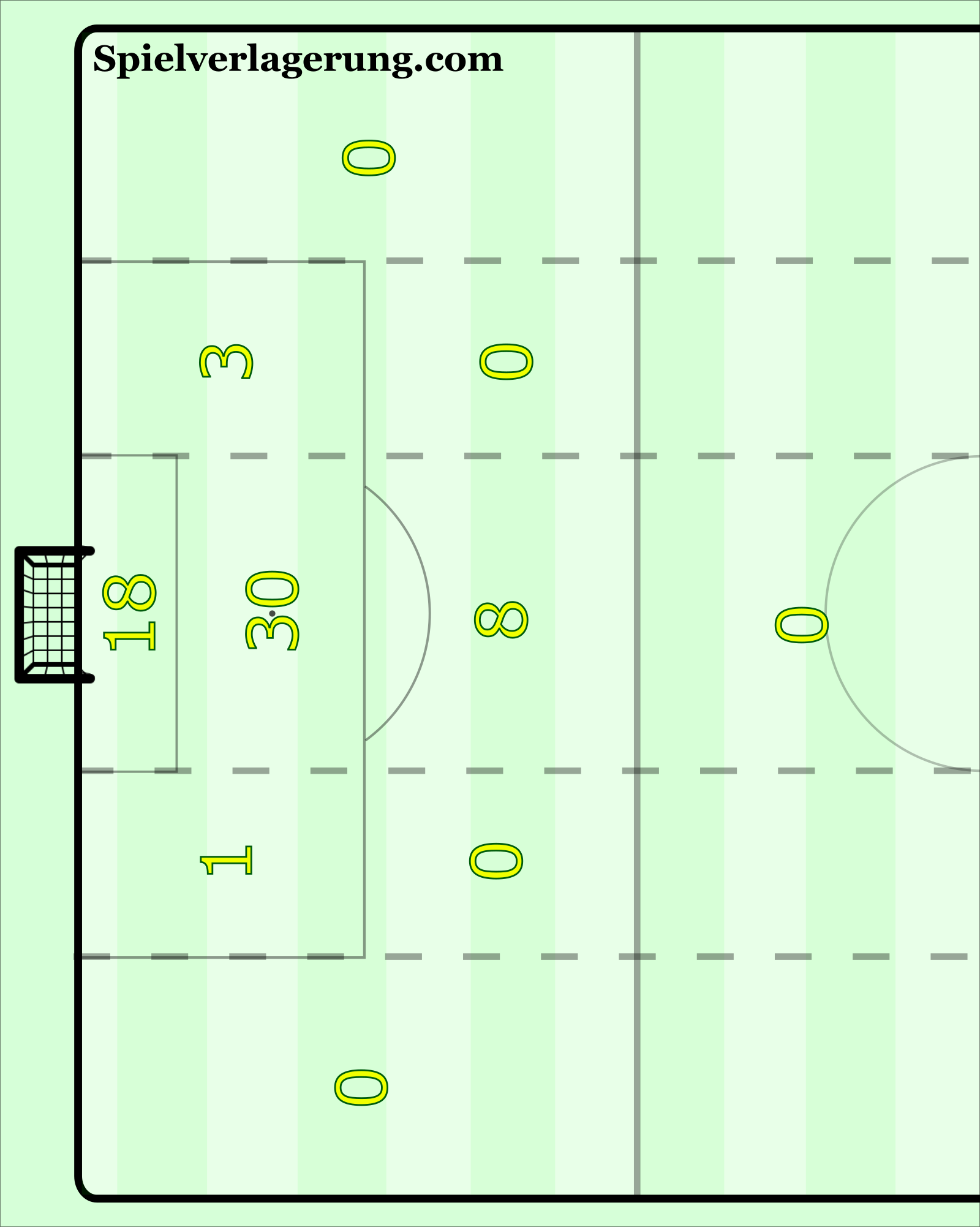
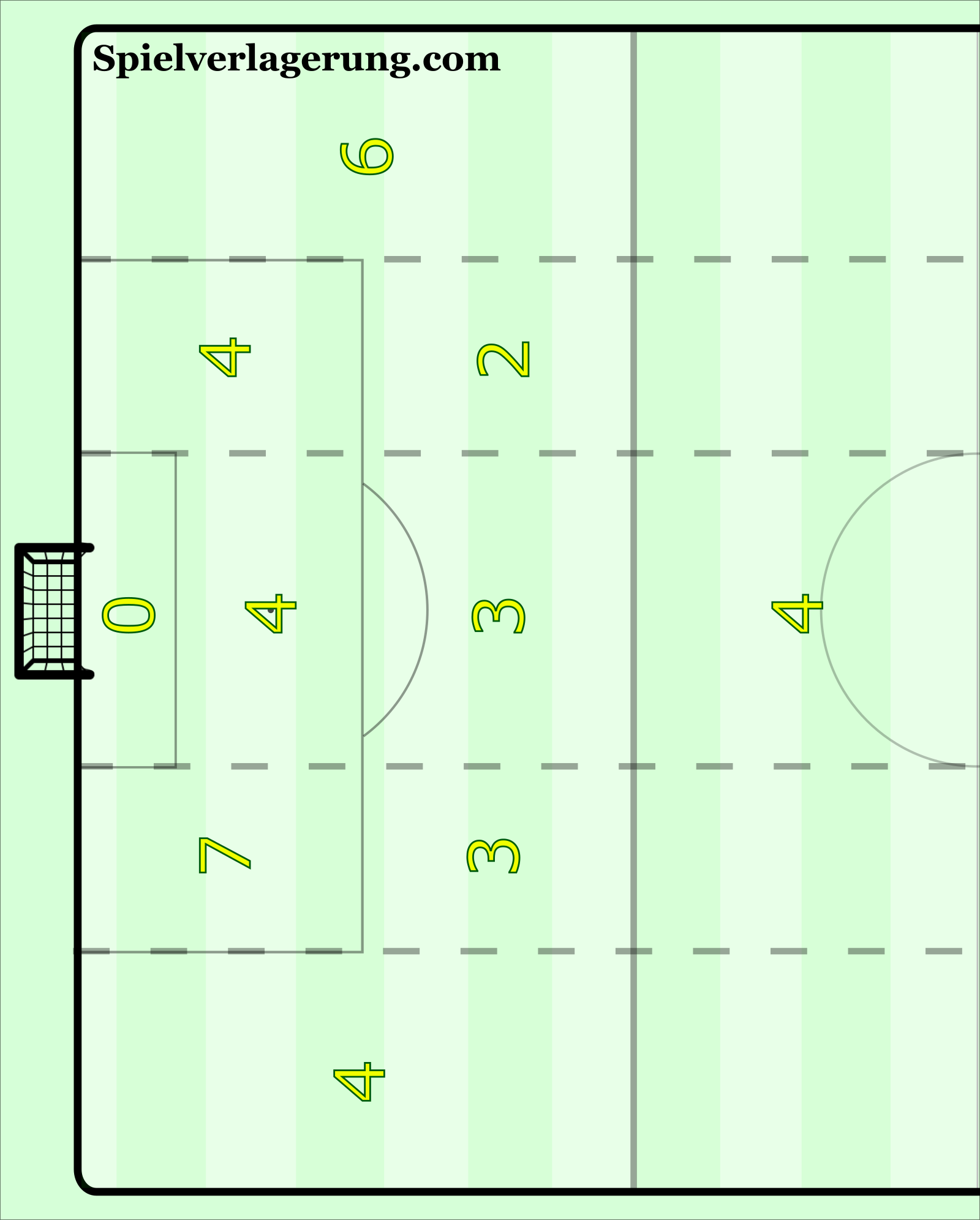
Other Assist Variables:
Unforced Errors – 5
Penalties/Set Plays – 7
Corners – 4
Unsecured Possession (e.g. Following a clearance/rebound etc.) – 7
From this evidence, it makes suggestions that not only are Norwich conceding goals from high xG locations within central areas through the 6 yard box and penalty area, but that the origin of the attacks are largely funnelled from wide-areas. The rationale for this could be varied, though initial observations from the statistical data combined with the tactical repercussions of the 4-2-3-1, could imply that Norwich’s full-backs are exposed to overloads in wide areas or even simpler that they are the weakness within the defensive structure. This could be due to the lack of recovery by the 7/11, though the 10’s recovery is also vital within this tactical system, as if they do not recover effectively Norwich are subject to central overloads when playing against 3 man midfields as well as in wide areas, which also provides the opposition with better opportunities to score in transition against Norwich by having a numerical superiority. However, regardless of the initial perceptions of the statistical data, it does provide a focus for latter tactical analysis of Norwich’s defensive effectiveness.
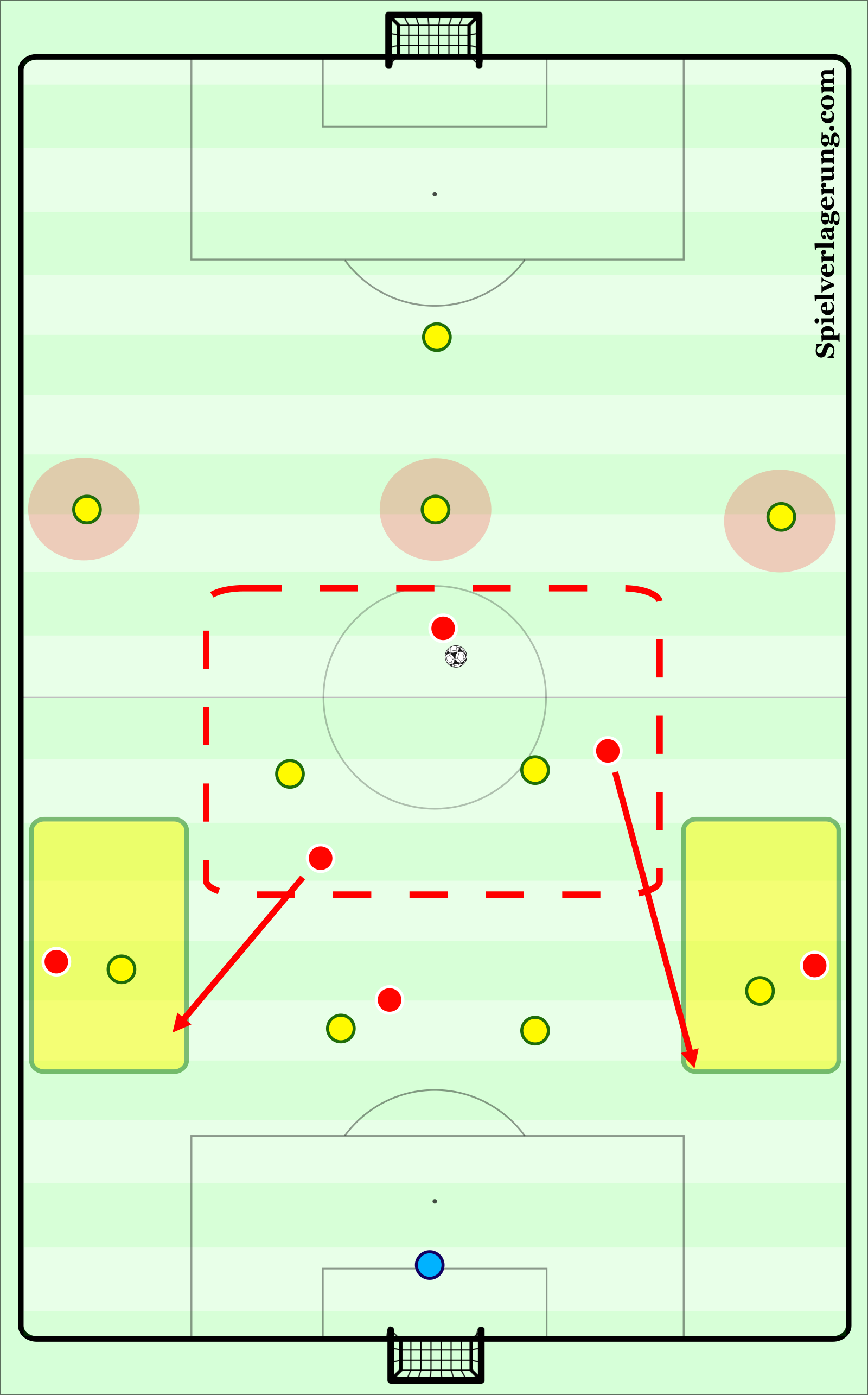
At the other end of the pitch, the statistics are almost as equally damning, yet there are some faint stems of hope for the Canaries in their attacking performance:
- 25 Goals Scored/0.73 Goals per Game (Lowest in the Premier League)
- 37.86 xG/1.18 xG per Game (17th in the Premier League)
- 344 Shots/9.99 per 90 Minutes (12th in the Premier League)
- 33.4% Shot Accuracy (18th in the Premier League)
- 276 Crosses/8.02 per 90 Minutes/25% Crossing Accuracy (Lowest in the Premier League)
Once again, initial viewing does not make for pleasurable reading. Norwich have the lowest goal-scoring output within the division, despite having a significant amount of shots and a vastly different xG of 37.86 compared to the mere 25 goals that they have scored. This demonstrates a blatant lack of quality within the final third when also considering the poor shot accuracy, which if improved could have them well and truly in the scrap to stay up. It is also significant to note Norwich’s lack of crosses with the lowest in the league, providing evidence that Norwich’s key aim is to play “through” the opposition as opposed to playing “around” them. However, further analysis of data highlights Norwich’s clear over-reliance on key individuals, with only Pukki (11) and Cantwell (6) scoring more than one goal. This is furthered by the assist charts, with only Buendia (7), Pukki (3) and Cantwell (2) registering more than one assist. This signifies that from an attacking perspective, it is imperative that when examining coaching implementations within the next section that the onus is upon enabling more players to influence attacking efficiency. Additionally, the breakdown of goal and assist locations below also demonstrate attacking implications.
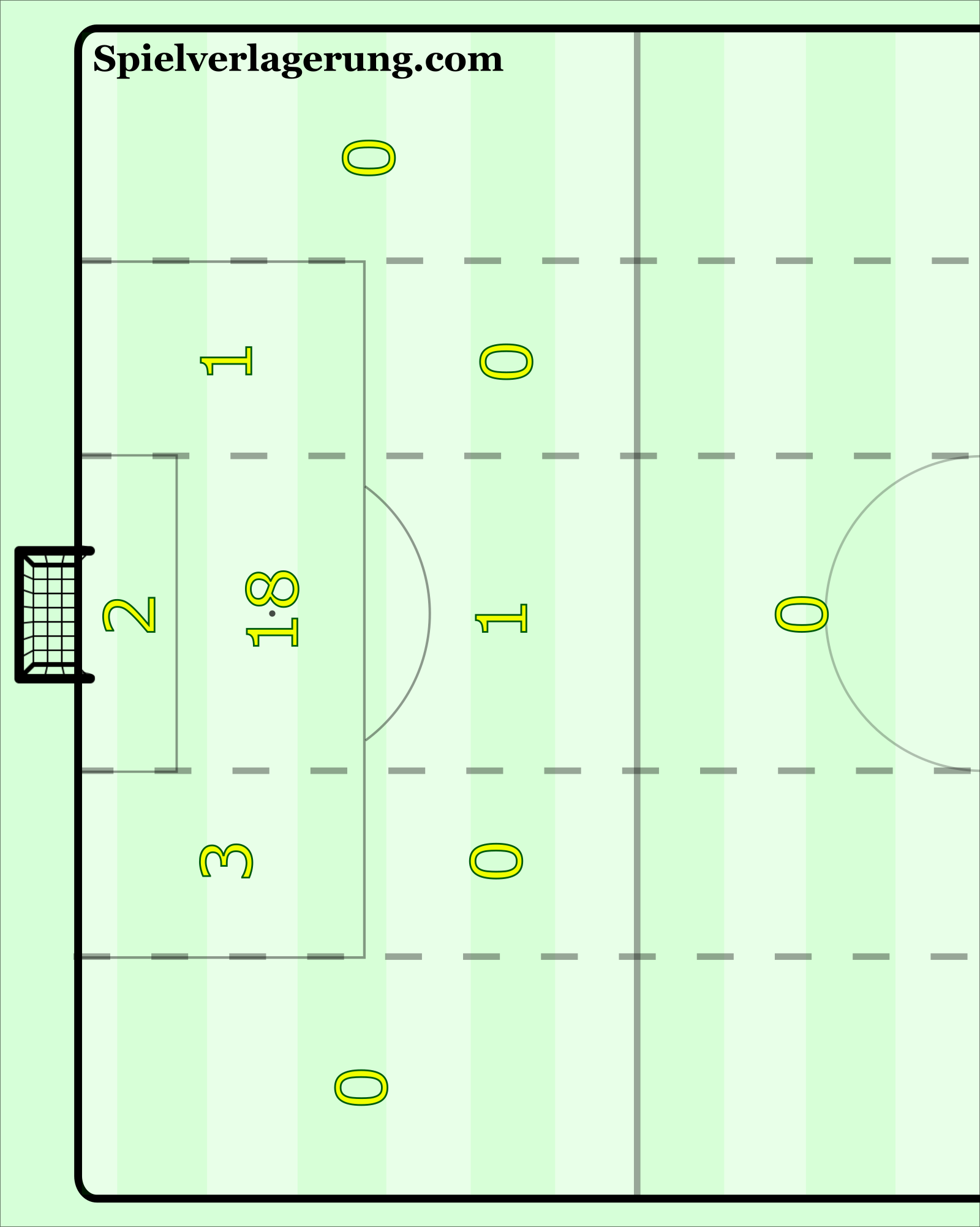
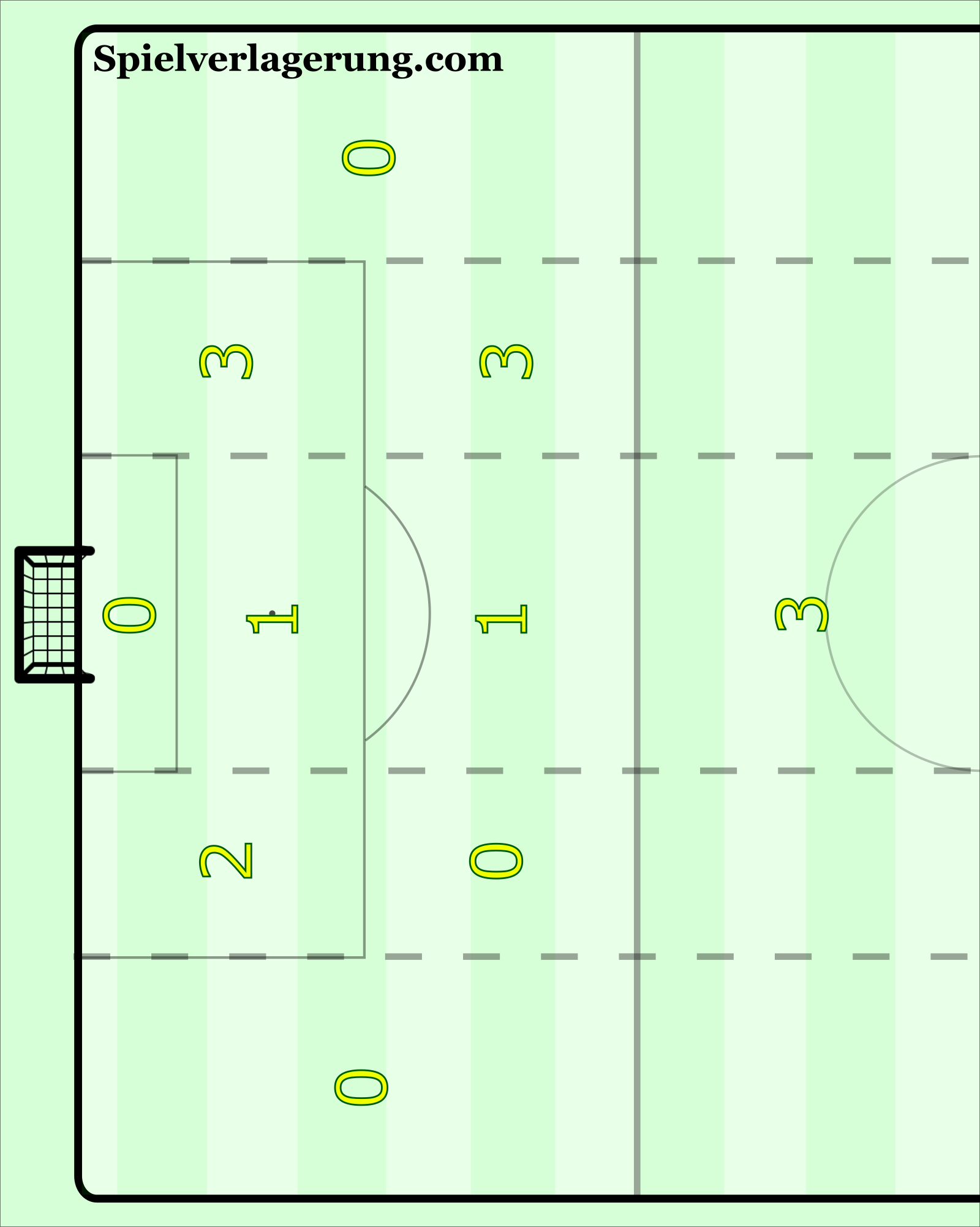
Other Assist Variables:
Unforced Errors – 3
Penalties/Set Plays – 2
Corners – 1
Unsecured Possession (e.g. Following a clearance/rebound etc.) – 6
An initial analytical observation is that a vast amount of “assists” are from unsecured possession or unforced opposition errors, suggesting Norwich do not create a vast amount of opportunities from their own possession. Further to this, when appreciating that only just over 50% of Norwich’s assists come from open play, this makes it even more applicable that Norwich need to be more efficient with the possession that they do have. Finally, there are no assists from wide areas, further illustrating the theory that the 7/11 tuck in narrow to combine with the 9/10 and create overloads to penetrate centrally, particularly as a number of assists are from the right half-space where Buendia has operated mostly throughout the season.
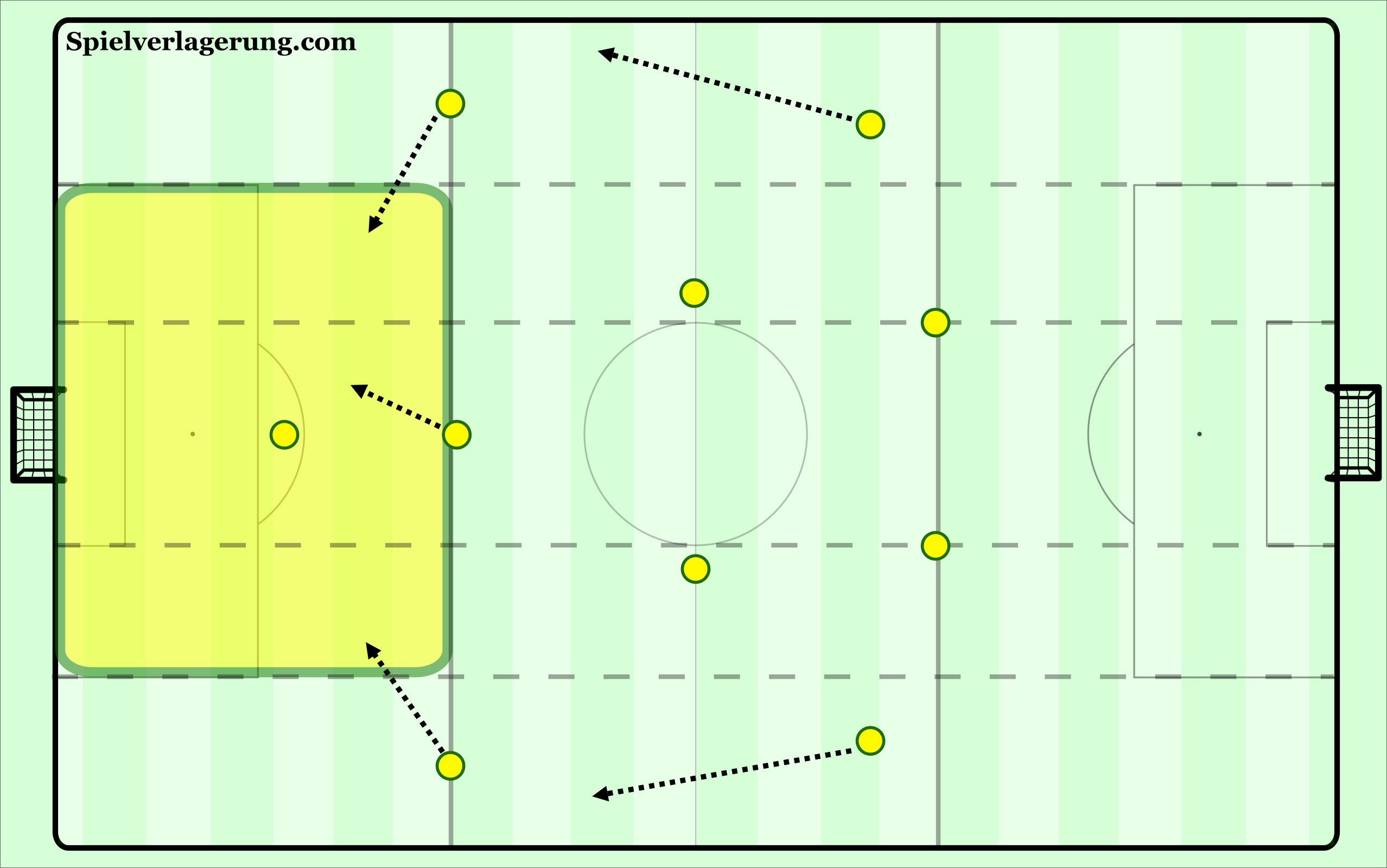
Given the influence of possession/passing efficiency upon Norwich’s attacking performance as well as the amount of pressure it may subject their defence to, it is relevant to analyse this from a statistical perspective, with key statistics below:
- 50.1% Average Ball Possession (9th in the Premier League)
- 399.47 Passes per 90 Minutes (9th in the Premier League)
- 83.4% Pass Accuracy (9th in the Premier League)
- 7.12 Through Passes per 90 Minutes (9th in the Premier League)
- 43.77 Passes to the Final 3rd per 90 Minutes (18th in the Premier League)
From the data, it is evident that retaining possession and dominating the ball regardless of the opposition is a mantra that Farke has pursued throughout the Premier League season, with plaudits warranted. Although, the data above provides clarity upon Norwich’s issues, despite having the 9th most passes per 90 minutes, they only rate 18th in passes to the final third.There is justifiability to dominating possession, but as Pep Guardiola conveys “if you do nothing with the ball then what’s the point”! Consequently, to improve performance Norwich must endeavour to increase their ability to penetrate through the midfield third with forward passes to propel them to create more opportunities in the final third. This is another vital area to be explored within the targeted coaching implementations in section 2.
Section 2 – Tactical Analysis & Coaching Implementations:
Building upon the initial statistical analysis, it is evident that the following areas are crucial to be improved through targeted coaching interventions ahead of a hypothetical season rewind, this would allow Norwich to solve the most critical and pressing problems they have faced during the 2019/20 season in a prioritised order:
- Improving Defensive Effectiveness
- Increasing Attacking Output & Ability to Penetrate
- Increasing Tactical Flexibility
As a result, the following sub-sections will tackle these issues on an individual basis using tactical evidence from Norwich’s games this season as a basis for coaching implementations.
Improving Defensive Effectiveness
Continuing from Section 1, the clear priority for Norwich City within a season rewind is to resolve the defensive issues that have seen them out-scored so vastly in the majority of their Premier League matches.
The first aspect to resolve is the lack of a perceived “attitude to defend”. Switching from an analytical to a coaching vantage point, this is a central basis in which Norwich need to improve with too many passive attempts at regaining possession within what the NFL would call the “Redzone”. Using the defensive third as the location for this “Redzone”, if Norwich are following universally trusted defensive principles such as Denying/Restricting, the opponents should be limited in the exploitation of space in the areas in front of Norwich’s goal.
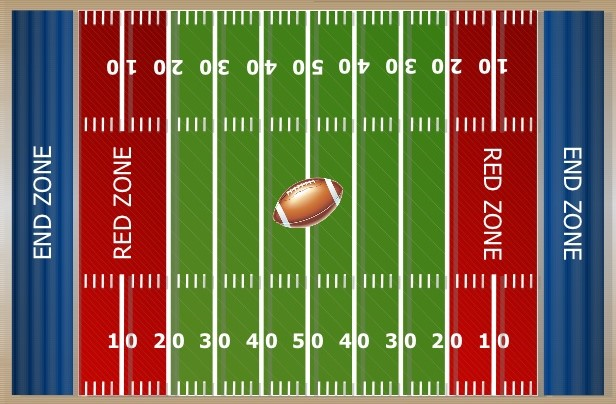
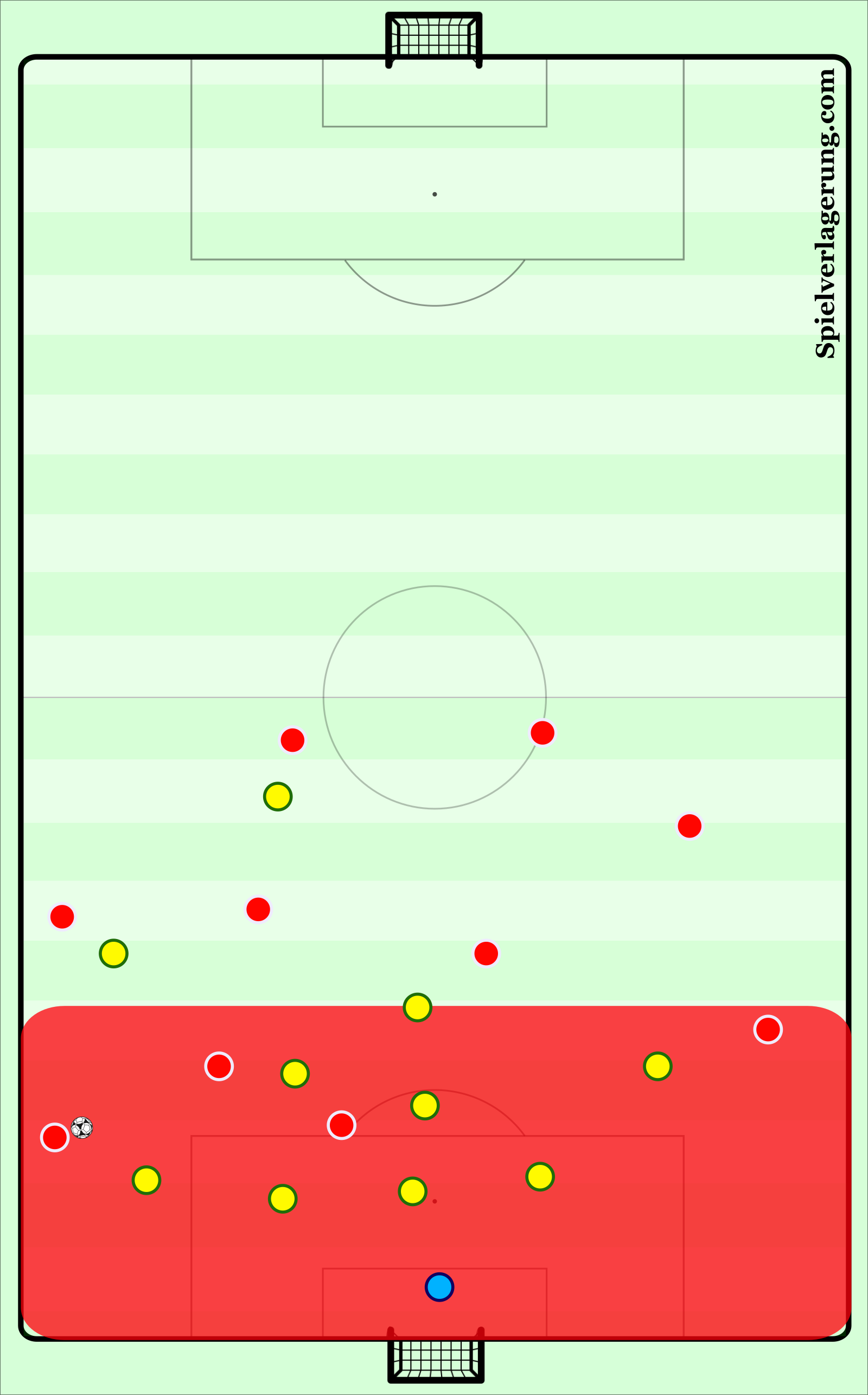
However, this is not the case as can be exemplified through the examples below. In the first example, Aston Villa find their way through a passive Norwich defence with no pressure upon the ball and concede despite Norwich’s numerical superiority. The second clip demonstrates Norwich’s vulnerability to crosses, with the Norwich defence making no attempt to compete aerially which results once again in a conceded goal.
The difficulty in implementing this change from an outsider’s perspective is that an “attitude to defend” is an intangible psychological and cultural component (Nesti, 2010). Therefore, it must be influenced directly by the coaches and environment that Norwich’s players find themselves a part of. Although, this should be introduced incrementally as to not disrupt through a widespread change. This can be implemented through constrained and conditioned coaching practices. Small-Sided Games could be rewarded with double points if a clean sheet is kept, goal-saving blocks within the “Redzone” in training could be rewarded with the same value of goals and simply placing “added value” upon defending within this area of the pitch throughout training will subconsciously affect players and performance outcomes. The importance of high performance environments can be found within Bill Walsh’ article with Harvard Business Review. The main outcome from this adaptation, is to reduce the vulnerability to conceding goals within the central areas of the penalty area, particularly in the first and second six yard box where Norwich have conceded almost all of their goals in the Premier League.
The second aspect to fix from a defensive standpoint, is the seemingly exponential vulnerability to conceding in wide areas. Following on from the basis of Section 1, we are aware that the statistical data indicates that Norwich’s full-backs are exposed, leaving the opposition with overloads in wide areas. This naturally results in time and space within the half-spaces and wider areas on either side of the pitch thus allowing good quality to be delivered into central areas for elite attackers to score, especially pertinent when finishing efficiency has rose within the Premier League this season. Therefore, the resolutions to this aspect need to not only increase the ability to defend crosses/cut-backs from these areas, but also to develop strategies to stop these at source.
In analysis of the reasons why Norwich concede from wide areas so prominently begins from their approach in possession, as highlighted in Section 1 with the tucking in of 7/11 into narrower central areas, forcing Norwich’s full-backs to provide attacking width. Whilst this may be suitable in possession, upon defensive transition there is a lack of defensive balance and security, allowing the opposition to quickly expose these wide areas to create attacks often leaving the central defenders exposed to 3v2 situations.
Furthermore, even when full-backs are able to recover there are issues evident within the length of recovery time by Norwich’s 7/11, most often Cantwell and Buendia, which results in Norwich’s full-backs being exploited through 2v1 situations leading to the previously mentioned opportunities in wide areas and half-spaces on either side. The contextual examples of this occurring throughout the season can be found below.
The issues deepen further when analysing clips tactically. It is unreasonable to suggest that full-backs should be able to defend against 2v1 overload scenarios, though it could be reasonable to suggest that they either engage upon the wingers first touch as to prevent them the opportunity to utilise the overload within the half-space, using awareness and the ability to press as a trigger as possession travels to limit opposition attacks in wide areas. Alternatively, full-backs could adjust their start positioning within the half-space, which is evidently a more dangerous position to force play out wide and restrict crosses from wider areas, at least reducing the availability for opposition attacking combinations – aiming to diminish the quality of delivery due to heightened distances into the box.
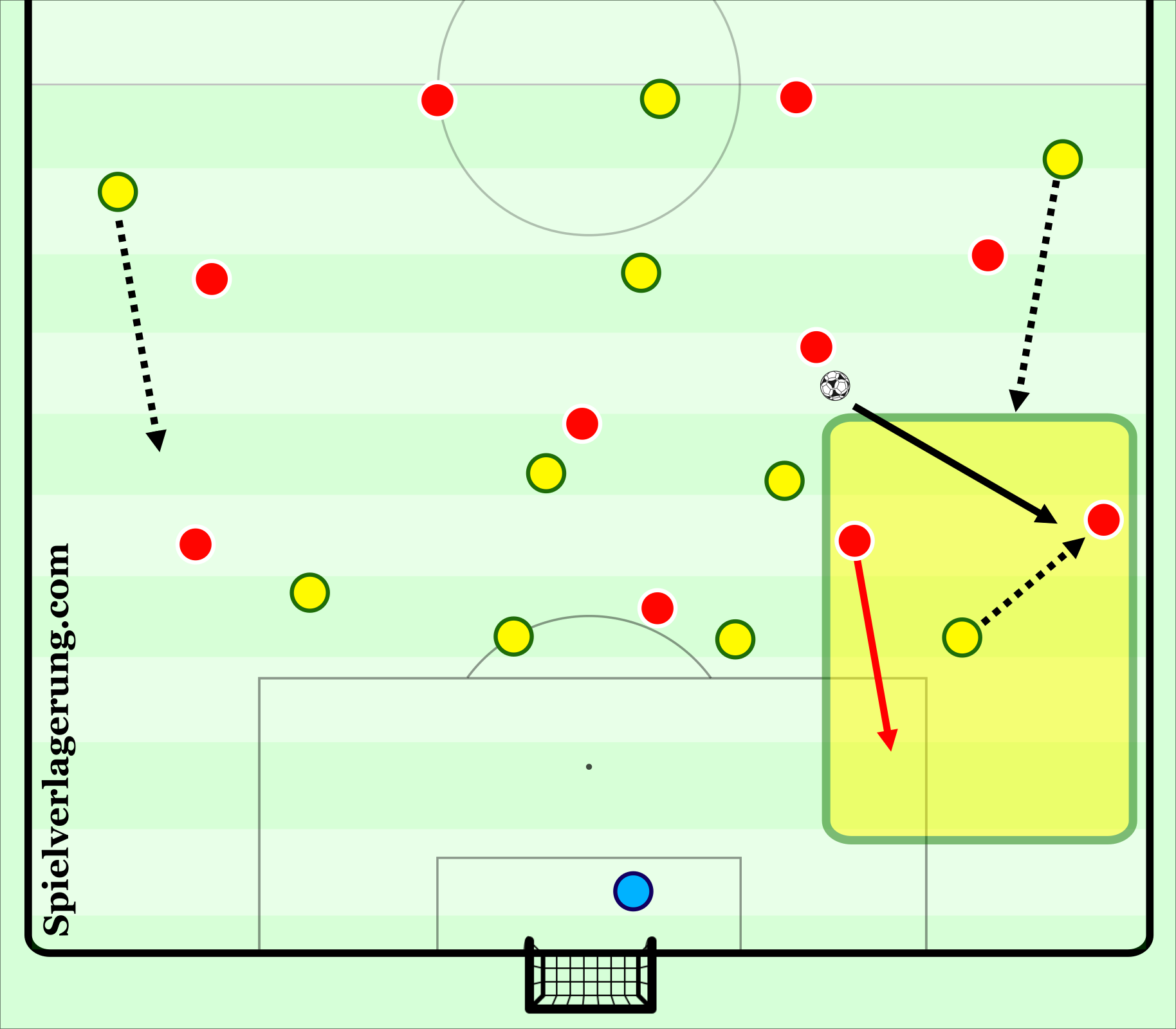
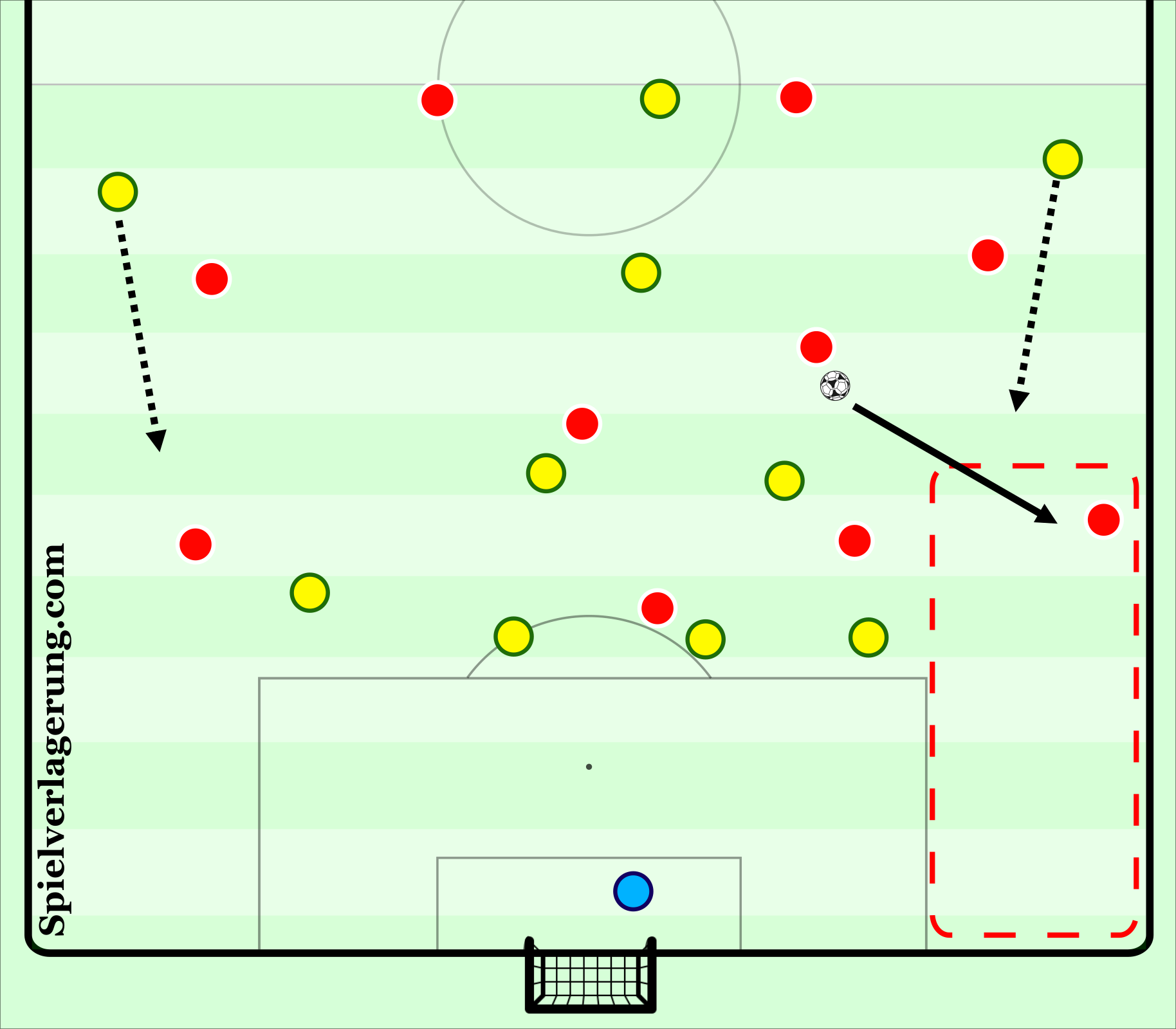
To counter-act these issues combined we propose a switch in tactical approach both in and out of possession to limit the weaknesses that Norwich have found themselves subject to throughout the year. The first implementation is to ensure that either the 4/8 remain as a secure single pivot when in the opposition’s half, not only does this free up the other central-midfielder (to be explored within the attacking adjustments as well) but it fundamentally allows this pivot to crucially delay and slow down the opposition when they are in an attacking transition to allow the Canaries’ full-backs to recover to defensive positions whilst also increasing the time in which the 7/10/11 can recover. Secondly, we have attached a man-specific recovery orientation to the 7/10/11 and focused more defensive responsibility on the shoulder of the 4/8/10 in central areas. The theory behind this is dual-based. First of all, it is possible for the 4/8 to better protect the exploited half-spaces and the recovering 10 can they fill in central areas for where space will be vacated. This means that the 4/8 cover the half-spaces rather than the central-defenders shifting across as this has exposed them even more to cut-backs and allows them to simply focus on protecting any deliveries into the first and second six yard box. In addition to this, Cantwell and Buendia are two of the three most influential and creative players in Norwich’s squad, allowing them the freedom to not recover in some scenarios and rather be in a position to propel counter-attacks in attacking transitions can also be beneficial to Norwich’s approach.
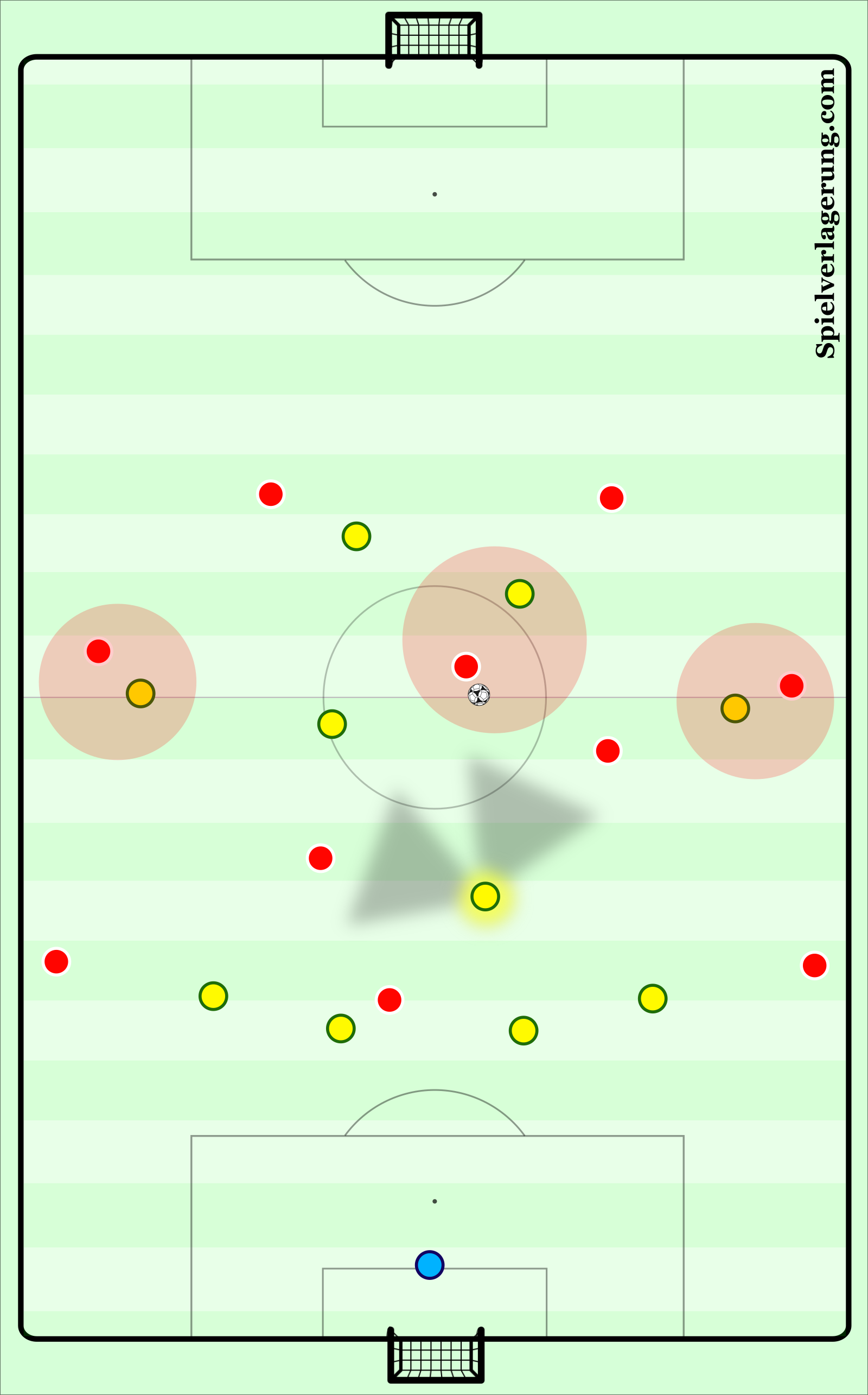
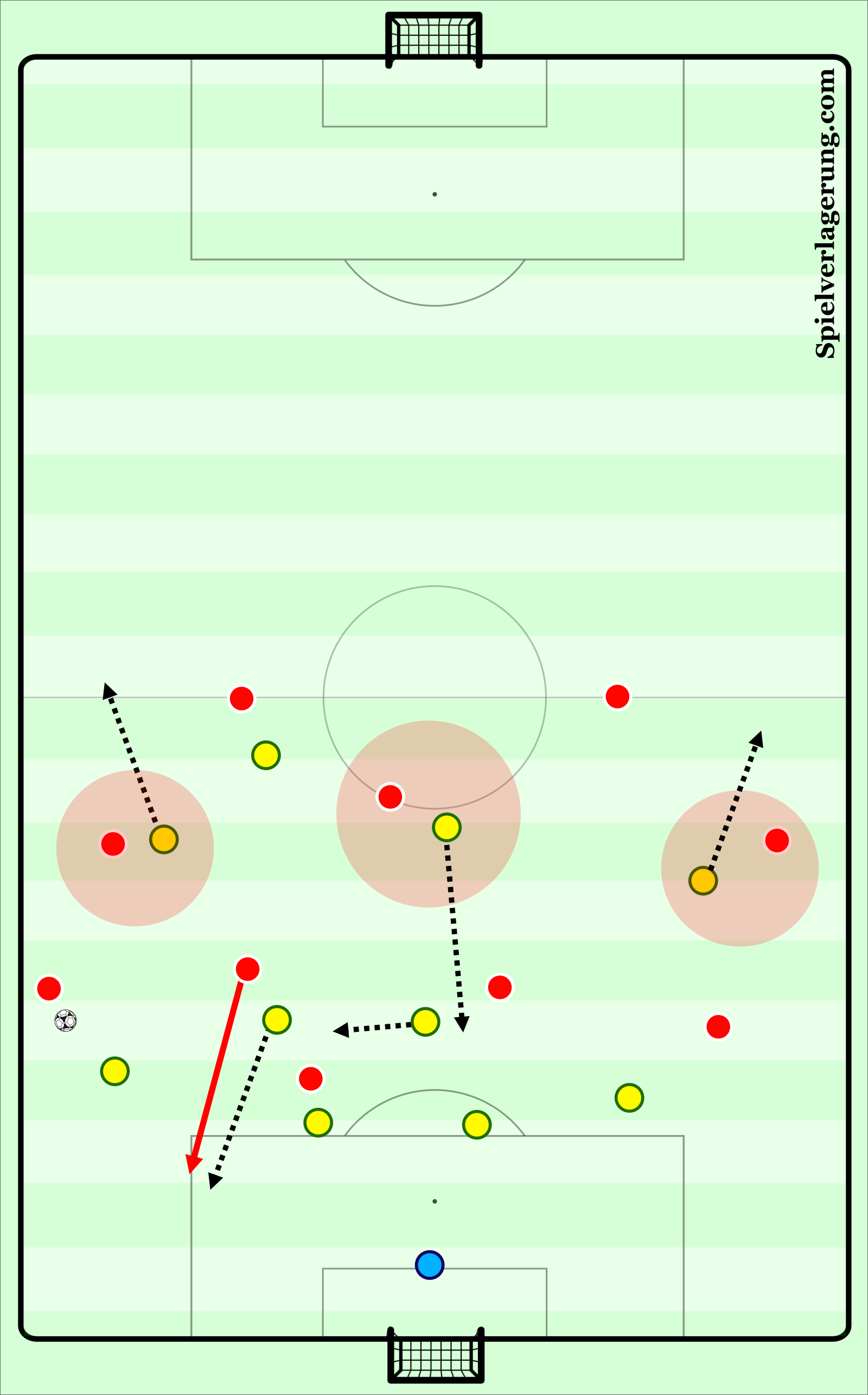
The attention now switches to how these changes can be implemented through coaching interventions to help Norwich’s Premier League performance within a season reboot both with subliminal and targeted practices. These practices have been broken down into three differing levels of practices that could be used across a training week.
The first of these is a subliminal transition 2v2 practice, focusing primarily upon defensive aspects whilst exposing moments for 2v1 overloads against the defenders. Within this practice, upon scoring the next opposition pair from behind the goal immediately launch an attack, forcing the now defenders to recover quickly and briefly creating 2v1s if one of the players isn’t able to recover effectively (e.g. If the yellow pair scored, the green pair behind the goal would immediately attack against them). In relation to Norwich City, this is ideal as it mimics the in-game realism of full-backs being overloaded in half-spaces and wide areas within the brief 2v1s, whilst also visualising the recovery runs of midfielders who we are targeting to recover into the half-spaces. It is also a useful practice from a defensive perspective, as it allows relationships to be built between players, e.g. pairing the two central-defenders or two central-midfielders to develop vital communication and social dialogue. This practice can be used with the full squad as an initial activity within coaching sessions, furthermore it has the dual-focus of attacking 2v2 which is also relevant to increase Norwich’s attacking efficiency. The coaching points should revolve around fundamental principles of delaying opponents attacking speed, restricting their passing options and pathway through central areas and “emergency defending” to block shots on goal.
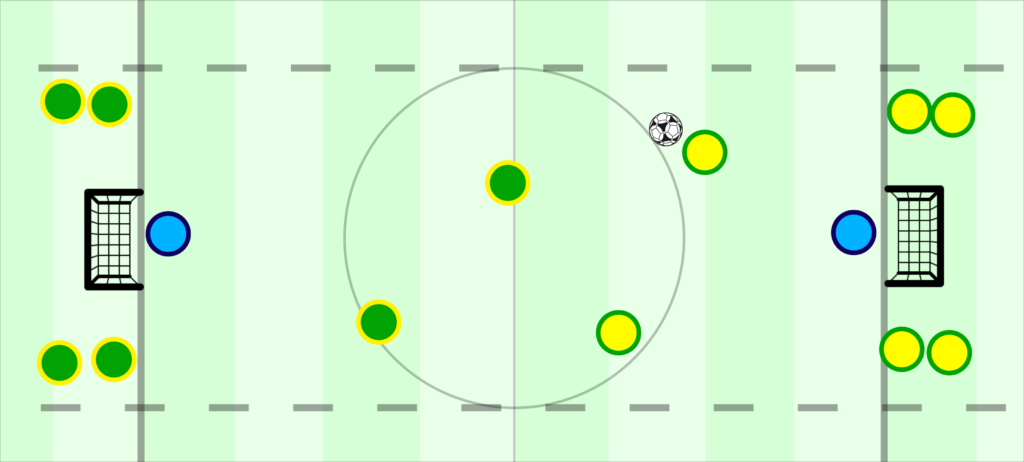
The second practice, is a larger practice with a specific focus upon the defensive and midfield units, prioritising the tactical adaptation of the midfielder recovering into the half-space, allowing central-defenders to remain and protect the most dangerous central areas. As displayed below, the team subject to coaching focus is the defending team with a back four, two central-midfielders and a recovering number 10 as Norwich would line up. The practice begins with the opposition midfielder playing the ball into the central area, from here the attacking team can attempt to score in any of the five goals. These goals are weighted; the central goal is worth 3 goals, half-space goals are worth 2 goals and outside goals are worth one. If the defending team win possession, they can score in either of the wide positioned goals for 3 goals – these mimic the positioning where Cantwell/Buendia would be for a quick counter-attack transition. The rationale is for Norwich’s defensive units to prioritise protecting central areas and force play into the wider areas to restrict both the opportunity to be penetrated centrally as well as the quality of deliveries into the first and second six yard box. The coaching points within this practice should primarily be the midfielders recovery to protect half-spaces, full-backs positioning to protect half-spaces or recognising triggers to travel and intercept passes and central-defenders body positioning/awareness to front-screen attacking runs within the first and second six yard box or cover/mark dependant on whether they are the near-side or covering central-defender.
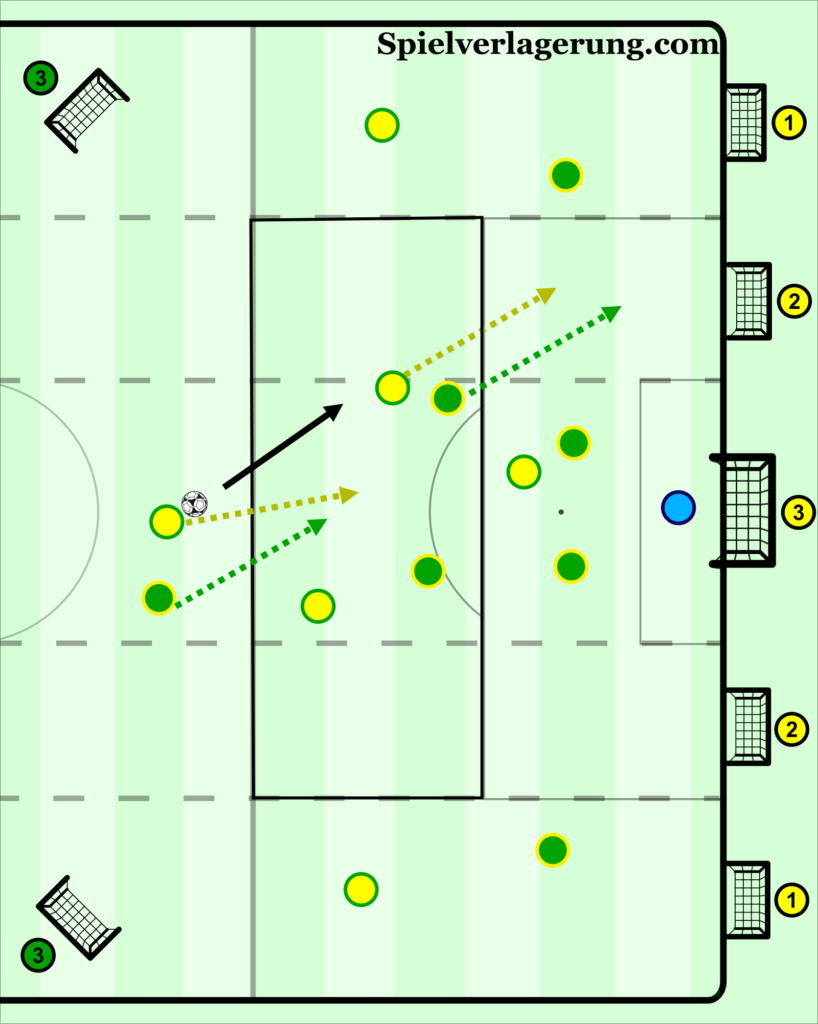
The third and final practice in relation to improving defensive effectiveness is a team-based practice, including all 11v11 players except Norwich’s striker and the opposition goalkeeper and central-defenders. The team subject to coaching is the defensive team with a back four, two central midfielders and a recovering 7/10/11. Upon the ball being played in by the bottom point of the opposition’s midfield three, the defending 7/10/11 can recover with their man-specific focus upon the full-backs and bottom point respectively. The aim for the higher positioned 8 and deeper single pivot is to delay play so that as the opposition reach the half-way line the 7/10/11 are recovered upon their respective players in order to maintain a defensive superiority numerically. Upon play reaching the “Redzone” as termed before, the priority should be to build upon the defensive principles within the previous sessions to force play into the wider areas, restricting direct penetration into the half-spaces and central areas. As a result, the opposition should be restricted by the midfielders covering half-spaces to cross from wide areas which can be cleared to develop attacking transitions. If the defending team regain possession, their objective is to score in the wide positioned goals as if breaking through Cantwell/Buendia. As a further caveat to the defending team, goal-saving blocks within the yellow shaded area are rewarded with a goal to develop the “attitude to defend”. The coaching focus should be upon the 7/10/11 initially restricting the opposition creating overloads wide or centrally through targeted recovery runs and the single pivot delaying the opposition attack. Further coaching points, from the previous sessions should also be applied.
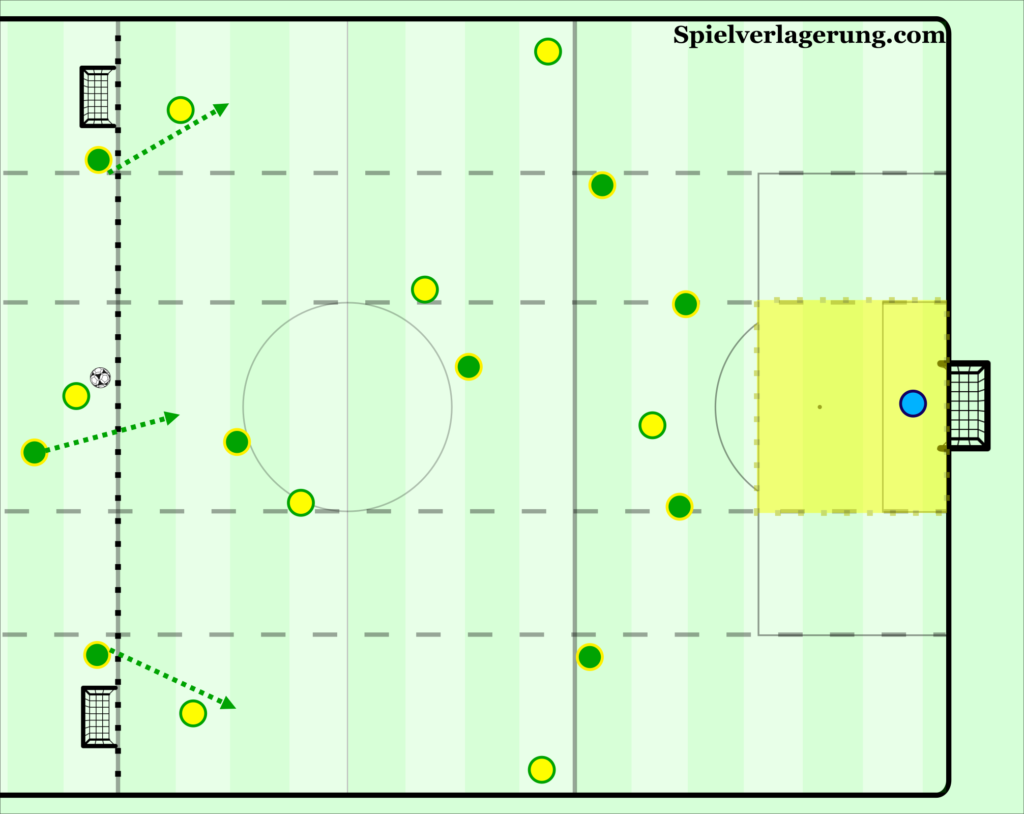
Increasing Attacking Output & Ability to Penetrate
The second element of Section 2 is to analyse and implement the improvements that can justifiably be made to Norwich’s attacking performance. Based upon the statistical evidence from Section 1, we can reasonably conclude that Norwich’s improvements when in possession largely form two areas for improvement – Quality/Efficiency of Finishing and Penetration into the Final Third.
The first area is a difficult one to approach, given that Pukki has scored 11 goals across the course of the Premier League season, though there is little support from elsewhere apart from Cantwell and Buendia. Given Norwich’s large discrepancy between xG and actual goals scored there is very little wrong with the chance creation in regard to its xG output and the problem lies with the proportion of these chances that are subsequently converted, especially when you consider that Norwich have had the 12th most shots in the league. Therefore, there is some rationale to focus session design purely on the ability to convert chances within the penalty area. However, when considering that assists are sparsely spread across the highlighted zones in Section 1 and accepting that a number of goals scored arise from unforced opposition errors, it may be relevant to focus some element of coaching implementations upon the combination play within the final third to increase the quality and fluidity of attacking movement. Although, the main focus to improve as implied within the defensive aspect may be freeing up an extra player such as the 8 to influence the attacking output. The addition of an extra player could influence the creation of attacking overloads, particularly in central areas where Norwich attack the most, aiding to disrupt the compact defensive structures that the opposition may look to employ. The second area to improve links into this nicely, the freeing up of the 8 may also allow an extra player to receive in behind the opposition’s midfield thus creating numerical advantages centrally and increasing the probability of Norwich penetrating into the final third, the area they perform vastly worse than other statistics from a passing/possession viewpoint. Therefore, the basis of our coaching implementations for Norwich’s season rewind will focus precisely upon this, freeing up the 8 and increasing tactical fluidity in the final third to increase the ability to break lines and penetrate whilst also heightening the chances of disrupting the opposition’s defensive structure in order to increase quality chance creation.
In analysis of Norwich’s current approach, there are a few required tweaks within tactical approach to make our changes successful. Currently, the full-backs are positioned high and wide supporting attacking play frequently, though given both the amount of crosses and the subsequent crosses are the lowest in the league in some way, this seems an ineffective usage and also leaves the Canaries significantly less defensive security. As a result, it means both Norwich’s 4 and 8 have to play as a double-pivot to maintain balance in their approach, limiting their ability to advance and support play.
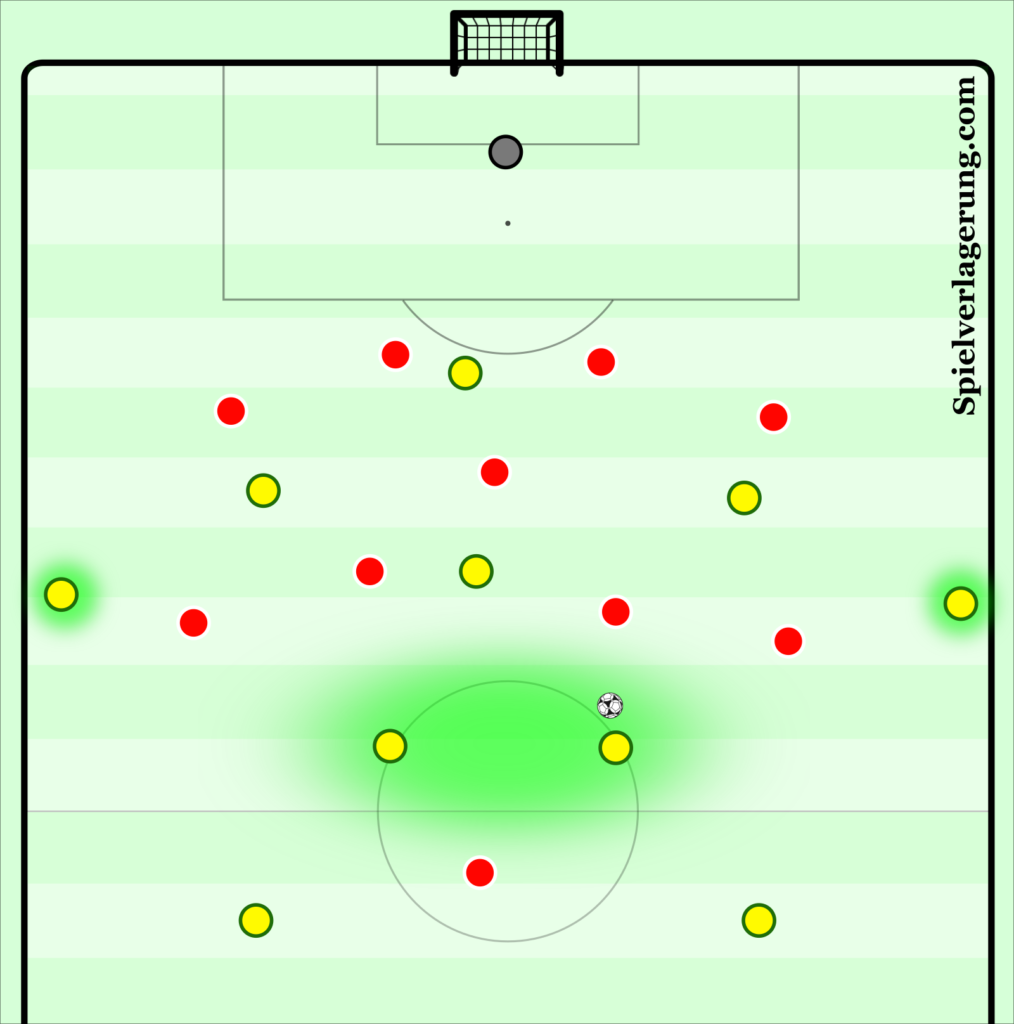
Alternatively, our suggestion is to drop the full-backs off to provide more defensive security and balance should possession be lost, yet still in a position to act as supporting players and bounce passes back inside as an option to break through the opposition’s defensive or midfield line. Consequently, this would release the opportunity for the 8 to push higher and create a central overload within the proverbial “Zone 14” which fitting Norwich’s existing style of play may lead to the increased penetration into the final third by having more players that are able to receive in behind the opposition’s midfield line. Further to this, it also provides the knock-on effect of allowing the 10 to push closer to the 9 posing more problems for the opposition’s back line.
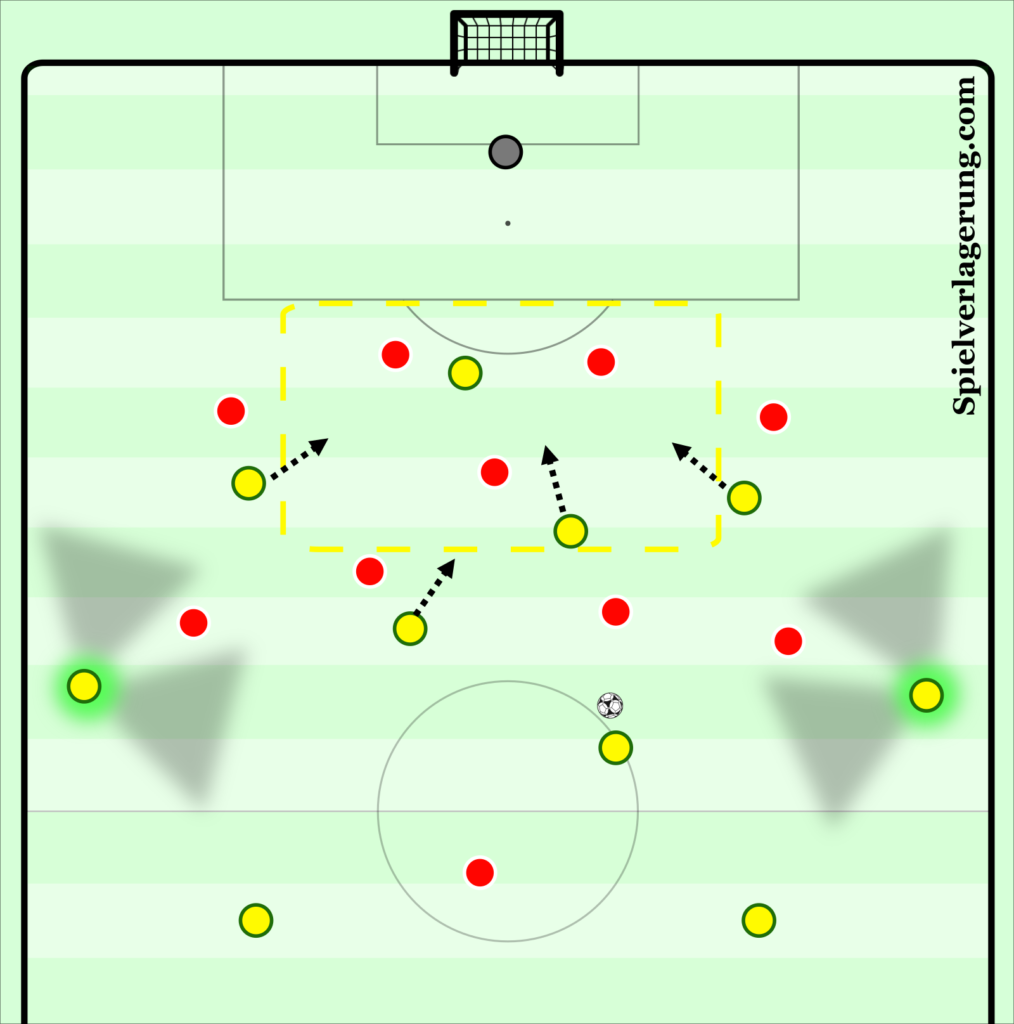
As a result, this tactical tweak should provide Norwich with a greater proportion of opportunities to penetrate centrally, the area which so much of the attacking play is funnelled through. In addition to this, it maintains defensive security as the single pivot can delay opposition attacks upon losing possession whilst the back four remain intact. Although, as to be explored within the contextual coaching implementations of these changes, it is still important to encompass an increase in rotational fluidity and the ability to penetrate opposition defences.
The first coaching practice, is an introductory element of a coaching session with an adapted rondo. The rationale is to subconsciously develop the ability to receive in tight scenarios, as would be replicated within the final third, with four bounce players on the outside and one floater in the middle to create a 4v3 overload (similar to that as highlighted above). The practice is scored by one of the teams combining to complete a set number of passes – though it would be encouraged to only have 2/3 quick combinations in the opposed area due to the congested nature of the practice. As referred to, coaching should be directly upon receiving in tight areas with a sub-focus of receiving “off the shoulder” of the opponents in order to break lines and play out to another bunce player quickly, this correlates to the scenarios the 7/10/11 will experience within the central lane and half-spaces of the pitch. As well as this, pressure should be upon rotations between players to disrupt the opposition, especially with the freedom of the extra man when in possession.
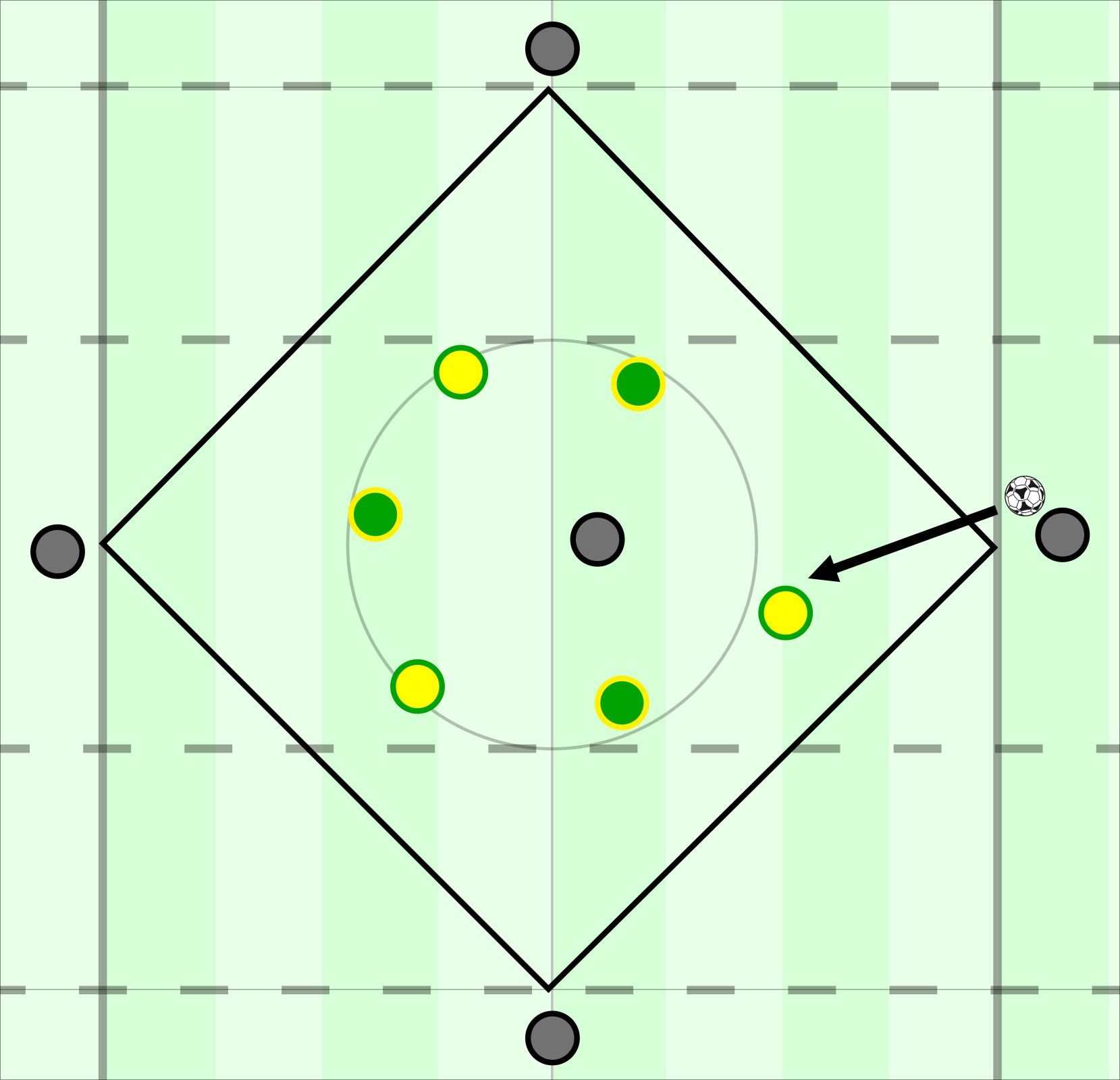
The second of these coaching implementations is a multi-directional possession practice which equates to the newly-adapted tactical strategy employed. Each team is made up of a 4 and 8 as the outside players, a 7/10/11 within the zoned central area and a 9 as a target player. The objective is to play the ball through the central zone and into the 9 to score a point, one of the team in possession’s 4/8 can make a forward run to create a central overload when his team are in possession as shown. Initially, the aim is to simply play the ball into the 9 who is being screened by two players to score a point, though this can be progressed into a more fluid practice with the addition of GK’s, creating the objective to score to gain a goal. The coaching objectives are plainly clear, utilise the extra man to receive in-behind the opposition’s midfield three in the central zone and create entries into what would be the final third within match play. However, focus should also be upon the encouragement of vertical and horizontal rotations between the 7/10/11 primarily, but also between the 9 and 7/10/11 to cause disruption to the opposition’s midfield and defensive line.
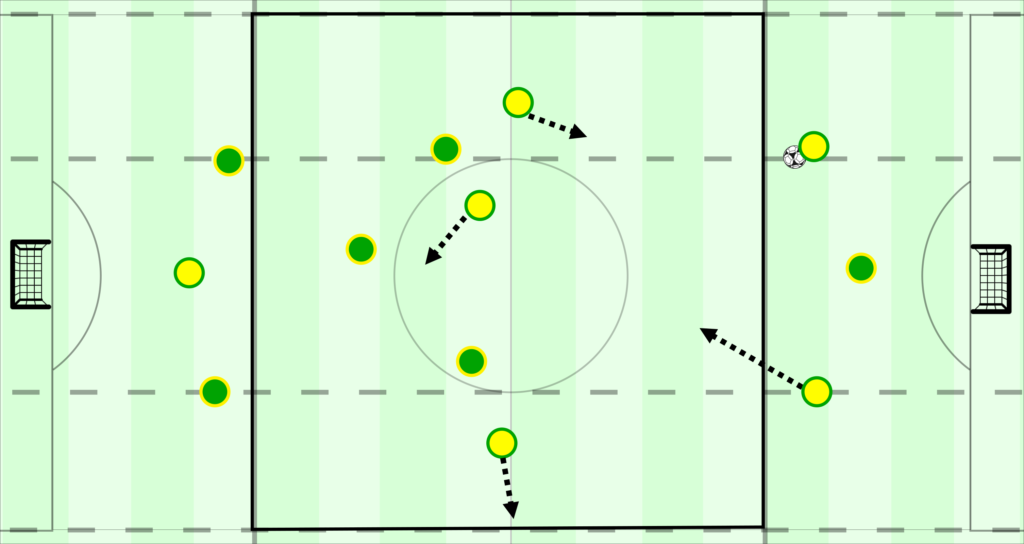
The final practice is a team-based practice without GK’s, with pitch constraints applied as shown. This relates to Norwich’s intent upon attacking through the central lane and half-spaces within the final third. The objective is for the attacking team (yellow) to score within one of the three goals, using the details coached within the previous two sessions, though the goal must be scored within the yellow shaded area – consistent with the theme of developing the ability to penetrate into the final third. If the defending team regain possession, they can transition to score in the single central goal with the single pivot aiming to delay the attack to allow man-specific player recovery from the 7/10/11, with play being forced into wide areas to restrict the attack – the defensive points highlighted within the improving defensive effectiveness should be evident. The practice can be adapted for specific match-preparation against differing opposition whilst retaining Norwich’s key attacking strategies and principles. Once again, consistent with our adaptations, the 8 should look to be able to receive to play in-behind or receive in behind himself, the 7/10/11 should look to create central overloads against the opposition bottom-point and central-defenders and rotational fluidity should be evident. The practice also provides clear opportunity to refine the full-backs positioning to maintain security upon losing possession.
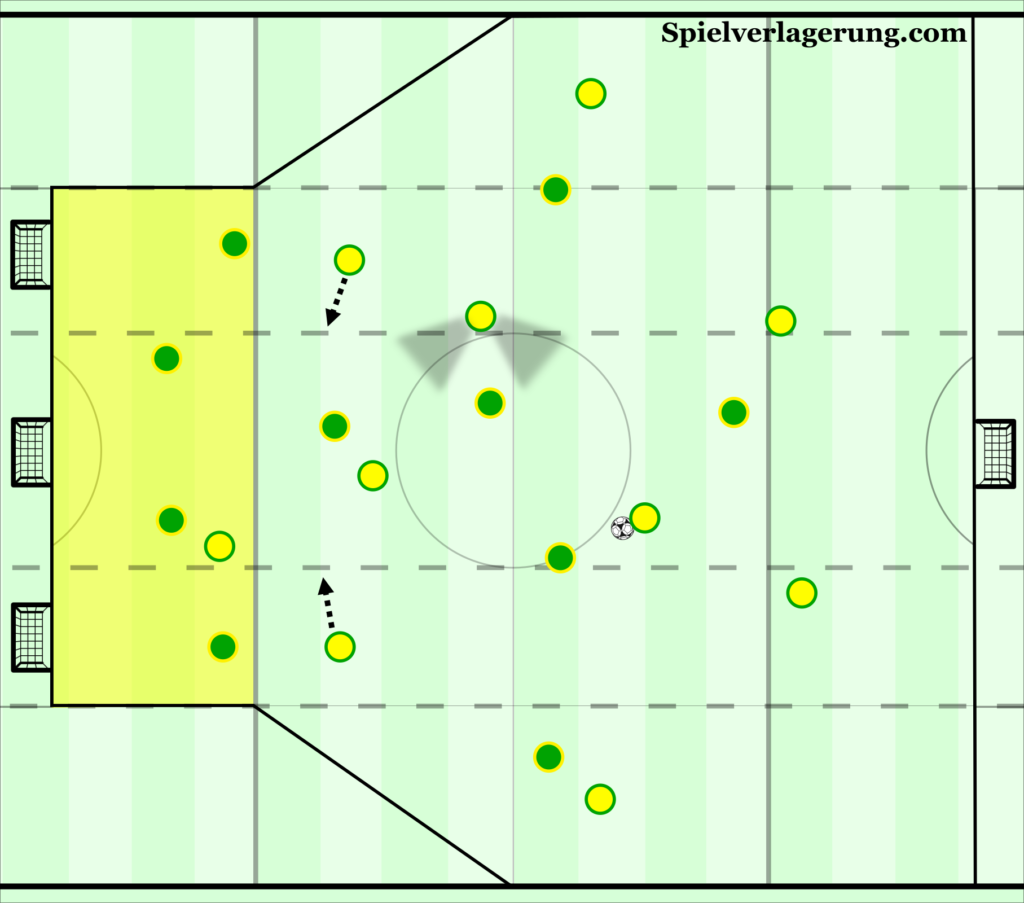
Increasing Tactical Flexibility
The final element of this section is incredibly brief and to a degree self-explanatory. As demonstrated within Section 1, Norwich have only ever used a formation based upon a back-four and most often this was a 4-2-3-1. Whilst this is completely acceptable and even with slight tactical improvements presented within this section, it does seem incredibly naïve that within one of the most tactically complex leagues in the world with a plethora of philosophies and ideologies present that Norwich have not even considered the use of other formations. As a result, our final suggestion and fitting within the adaptations suggested is the development of an alternative formation prior to a season rewind in which we argue a fluid 3-4-3/5-2-3 would be the most suitable for a variety of reasons.
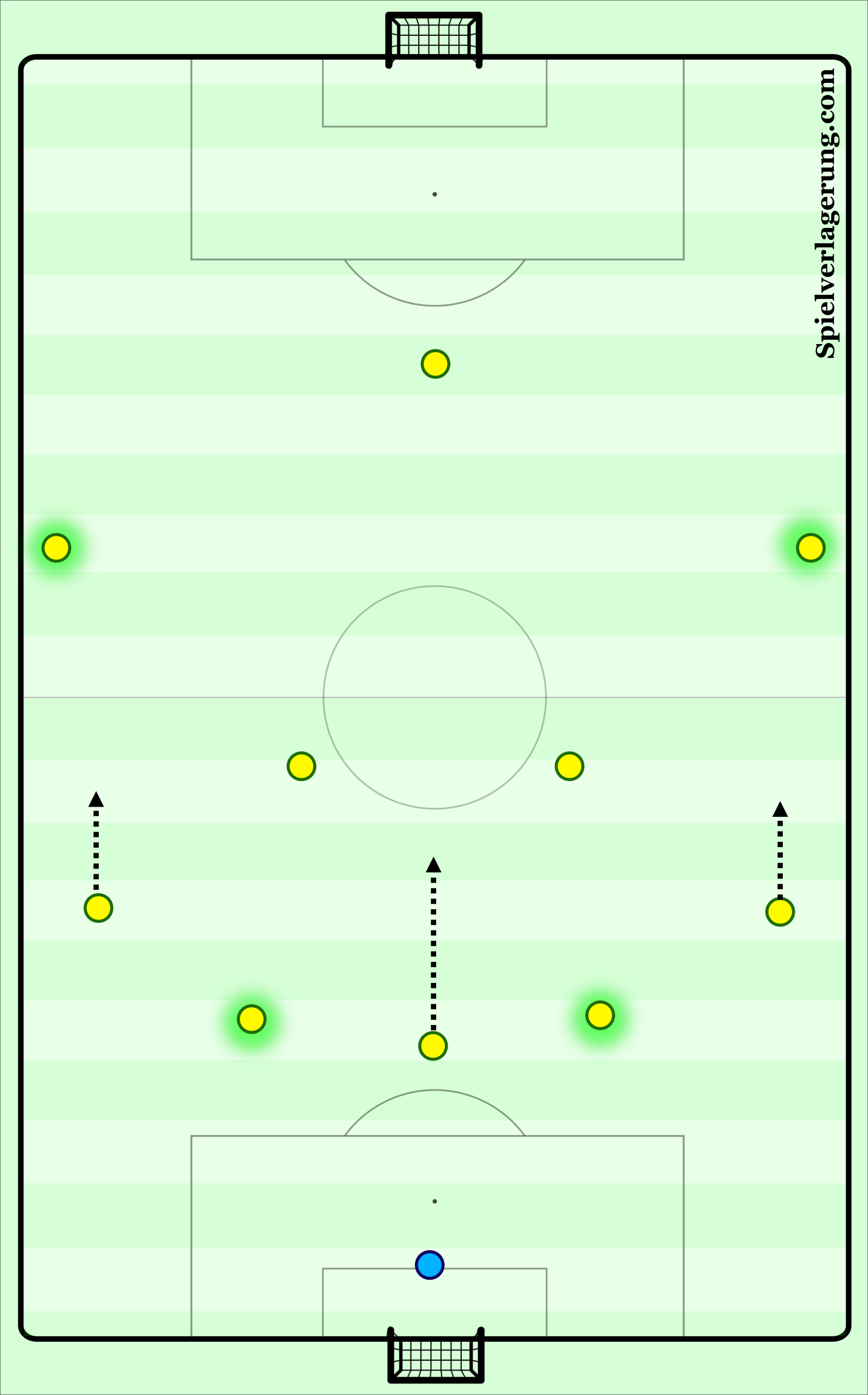
Firstly, it better protects the half-spaces (and wide areas if a 5-2-3) that are so often exploited from the Canaries defensive perspective and could provide extra cover especially against front-threes who may have the 7/11 as inside forwards with overlapping full-backs. Also, it provides the ability within these situations to quickly change within the game within an established familiarity with the roles of responsibilities of the 3-4-3/5-2-3.
Secondly, it is built for Cantwell/Buendia to not heavily recover and therefore provides opportunities for Cantwell/Buendia/Pukki to break in attacking transition within matches where Norwich may be locked into a low-block and struggling to gain possession. In addition to this, it also provides the flexibility for full-backs/wing-backs to play higher or deeper dependent upon the state of the game. Consequently, it provides a wider array of tactical flexibility and may be suitable for certain parts of matches where a tactical switch may provide beneficial to the end result.
Finally, it doesn’t “HAVE” to be played as a traditional 3-4-3 or 5-2-3. There could be opportunities for one of the central-defenders to step into midfield and create a three man midfield should possession be secured and the game state allows Norwich the security to do this. Not only does this increase tactical flexibility, but the increase in vertical rotation could disrupt the opposition and create moments within matches for Norwich to exploit.
Ultimately, this increase in tactical maturity and familiarity may not be a direct influence upon Norwich picking up a huge increase in points, though it does provide more options for Daniel Farke to play with during matches and could be vital to draw upon at certain times during the season.
Conclusion
In conclusion, there are an array of areas where Norwich have disappointed this season and a number need to be addressed within any hypothetical season rewind in order for them to have any opportunity to stay up. Although, there are stems of hope and as this piece portrays a few analytical/coaching interventions could increase their chance of survival. Unfortunately, the Canaries will never get this chance though it is interesting to consider for next season, whether these implementations can be made or they take a completely different route. Much of this may relate to whether the influential trio of Pukki, Cantwell and Buendia stay at Carrow Road, regardless it will be intriguing to see how Daniel Farke addresses the raised issues next season.
Keine Kommentare vorhanden Alle anzeigen